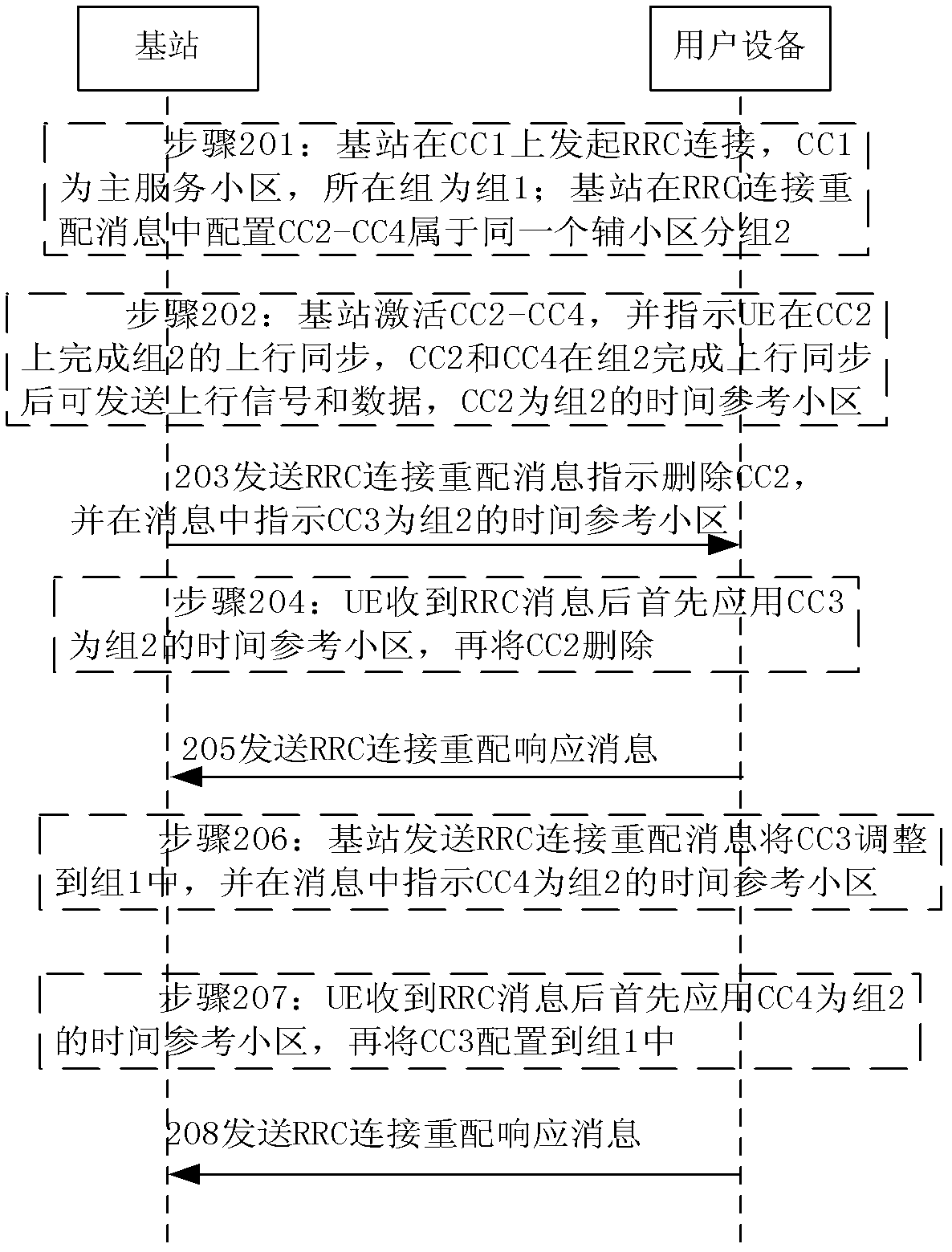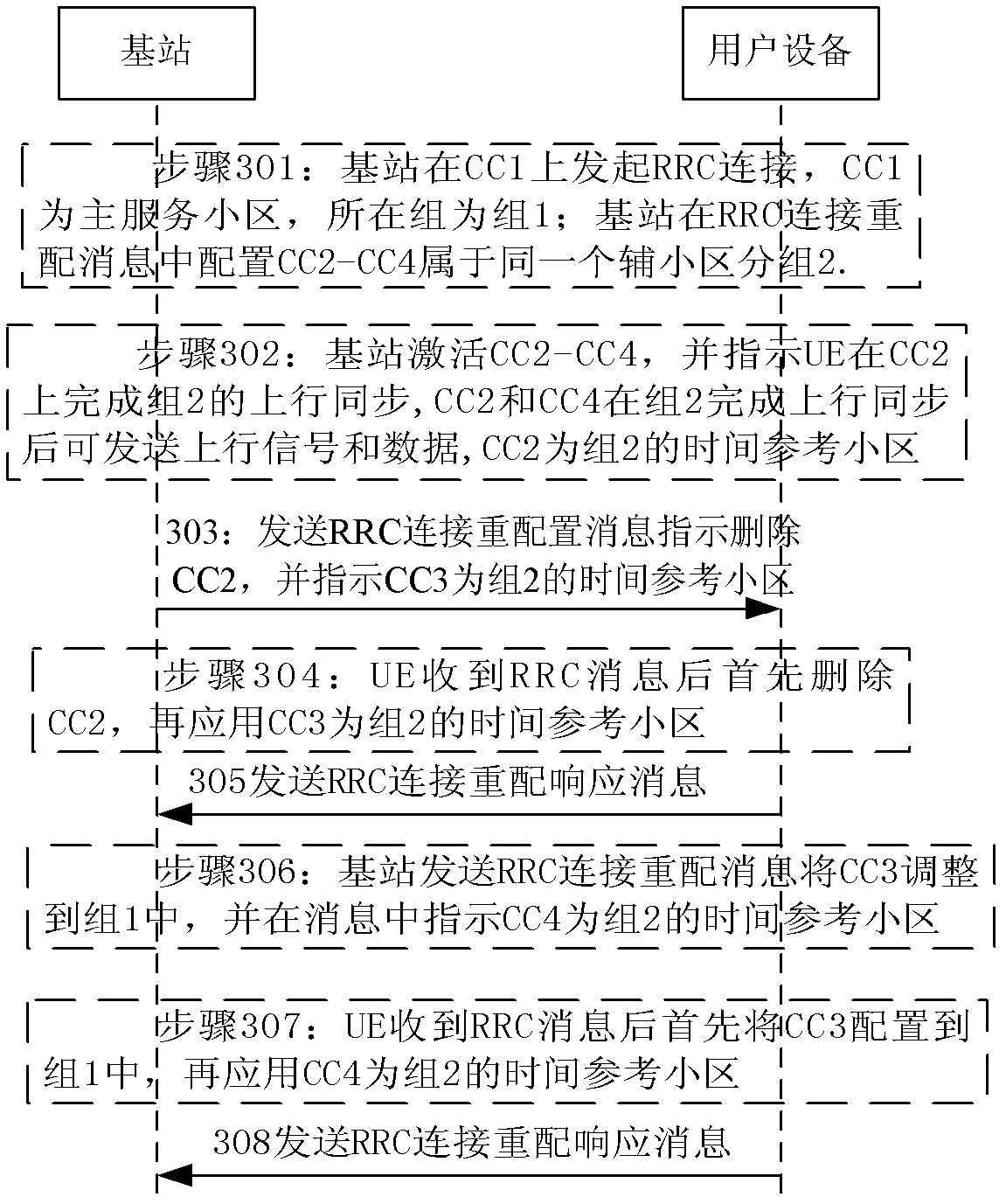Modifying method and device for time-reference cell
A technology of time reference and cell, applied in connection management, wireless communication, electrical components, etc.
- Summary
- Abstract
- Description
- Claims
- Application Information
AI Technical Summary
Problems solved by technology
Method used
Image
Examples
Embodiment 1
[0066] Such as figure 2 As shown, the method for modifying the time reference cell in this embodiment includes:
[0067] Step 201: UE initiates an RRC connection on CC1, and the base station configures CC2, CC3 and CC4 information and grouping information to UE in an RRC connection reconfiguration message;
[0068] CC1 is the primary serving cell, forming group 1, and CC2~CC4 are secondary serving cells, forming group 2;
[0069] Step 202: The base station activates CC2~CC4 when the UE is in the RRC connection state, and instructs CC2 to initiate a random access process to complete uplink synchronization; after group 2 completes uplink synchronization, it can send uplink signals on CC2~CC4, and CC2 acts as group 2 The time reference cell;
[0070] Step 203: After a period of time, when the base station needs to delete CC2, send an RRC connection reconfiguration message to indicate the deletion of CC2, and indicate in the message that CC3 is the time reference cell of group ...
Embodiment 2
[0077] Such as image 3 As shown, the method for modifying the time reference cell in this embodiment includes:
[0078] Step 301: The UE initiates an RRC connection on CC1, and the base station configures CC2, CC3, and CC4 information and grouping information to the UE in an RRC connection reconfiguration message;
[0079] CC1 is the primary serving cell, forming group 1, and CC2-CC4 are secondary serving cells, forming group 2.
[0080] Step 302: The base station activates CC2~CC4 when the UE is in the RRC connection state, and instructs CC2 to initiate a random access process to complete uplink synchronization; group 2 can send uplink signals on CC2~CC4 after completing uplink synchronization, and CC2 serves as group 2 The time reference cell;
[0081] Step 303: After a period of time, the base station needs to delete CC2, send an RRC connection reconfiguration message to indicate the deletion of CC2, and indicate in the message that CC3 is the time reference cell of grou...
Embodiment 3
[0088] Such as Figure 4 As shown, the method for modifying the time reference cell in this embodiment includes:
[0089]Step 401: The UE initiates an RRC connection on CC1, and the base station configures CC2, CC3 and CC4 information and grouping information to the UE in an RRC connection reconfiguration message;
[0090] CC1 is the primary serving cell, forming group 1, and CC2-CC4 are secondary serving cells, forming group 2.
[0091] Step 402: The base station activates CC2~CC4 when the UE is in the RRC connection state, and instructs CC2 to initiate a random access process to complete uplink synchronization; after group 2 completes uplink synchronization, it can send uplink signals on CC2~CC4, and CC2 serves as group 2 The time reference cell;
[0092] Step 403: After a period of time, the base station needs to delete CC2, and the base station sends an RRC connection reconfiguration message to instruct to delete CC2;
[0093] Step 404: After receiving the RRC message, ...
PUM
 Login to View More
Login to View More Abstract
Description
Claims
Application Information
 Login to View More
Login to View More - R&D
- Intellectual Property
- Life Sciences
- Materials
- Tech Scout
- Unparalleled Data Quality
- Higher Quality Content
- 60% Fewer Hallucinations
Browse by: Latest US Patents, China's latest patents, Technical Efficacy Thesaurus, Application Domain, Technology Topic, Popular Technical Reports.
© 2025 PatSnap. All rights reserved.Legal|Privacy policy|Modern Slavery Act Transparency Statement|Sitemap|About US| Contact US: help@patsnap.com



